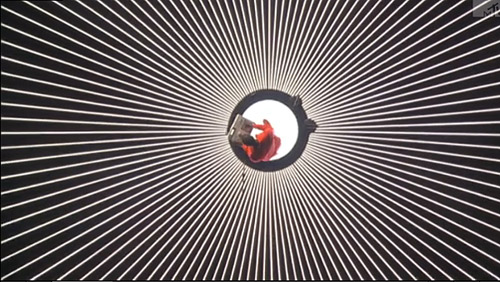The Cyborg, Anatomized
By:
October 12, 2010
It’s at the juncture of the “angry opposition of cybernetic and architectural thinking” that Tim Maly situates Quiet Babylon, his blog about “cyborgs, architects, and our weird broken future.” Throughout the month of September, Maly hosted an event he called 50 Posts About Cyborgs to celebrate the fiftieth anniversary of the term “cyborg,” a concept first articulated in a 1960 paper by Nathan Kline and Manfred Clynes. Maly invited fifty artists, bloggers, editors, and writers (including HiLobrow contributors Tim Carmody, Alexis Madrigal, Geoff Manaugh, Peggy Nelson, Annalee Newitz, and myself) to engage, defend, or disassemble the cyborg. Tim’s cybernetic cavalcade garnered coverage — and conversation — from io9.com and theAtlantic.com to the Guardian.co.uk and CBC radio’s Spark. In the first week of October, Maly and I met in Google Docs to discuss the conception and execution of this extraordinary online event; an edited and condensed version of our chat appears below.
Several commenters have noted the unique shape taken by 50 Posts About Cyborgs. At Snarkmarket, Robin Sloan talked about it as a new, refractory kind of anthologizing. Where did the idea to do the project as a slow-burning event come from? Did you have models for it, or was it a spark out of nowhere?
Robin and Tim’s work at Snarkmarket played a huge role in the conception of this thing. In particular, Robin’s Bet on Events and Stock and Flow posts and Tim’s Author-Functions and Work-Functions.
There were also a few working models that I drew from, or designed in response to: BLDGBLOG’s Glacier Island Storm tie-in, Longshot Magazine, Robin Sloan’s Annabel Scheme follow-up, and Small Wooden Shoes’ Dedicated to the Revolutions.
The other half of the origin, I’m sad to say, came out of a period about a year ago where I was reading those obnoxious “how to get traffic” blogs. A lot of the advice they give is terrible or feels sleazy, but one idea I thought was useful was that you should try to lead the news. If you could look ahead and see something that was likely to garner attention, you could set yourself up to have work that ready for when it did (in Robin’s language, building up stock in anticipation of a moment of high flow). For example, if you know the Olympics are coming up (and they come up like clockwork) you make sure you have some fresh material about the Olympics ready to go Casting around for important upcoming dates, I realized that “cyborg” was turning 50. I carried that knowledge in my back pocket and had been thinking about what to do with it since.
That’s funny —I understand that impulse entirely. But when did the particular framework of this as a kind of — of what?— distributed bloggy magazine/seminar/unconference — how did that begin to emerge?
I’m lucky to have this great community (clique?) that’s emerged around a bunch of people who’s work I love who have a family resemblance of obsessions. I’d been talking up the anniversary with some of them; we’d talked about a cyborg week, or some other themed event.
Geoff Manaugh was a big proponent of the idea that I should aim bigger, try to go for something that was slightly outside of my grasp. At some point the phrase “50 posts about cyborgs” started running through my head. I couldn’t stop thinking it so I started reverse engineering the design from that product.
It’s worth pointing out that the format I settled on isn’t an invention, it’s a re-invention. In his wonderfully astute retrospective of Cyborg month, written from fifty years in the future, Paul Raven notes that this has been done before.
We were just, as Maly put it, ‘doing a thing’: our little slice of the blogosphere, the more chinstrokey end of the esseff and/or futurist club, rerunning the blog carnival format about two years after it died off at the hands of a search algorithm tweak. It’s like being in a band, I guess; by the time you’ve realised your audience is too small to pay your way, you’ve fallen too hard for the music itself to ever stop playing.

This project seems a little different from the classic blog carnival, though, in the extent to which it was a performance. 50 Posts About Cyborgs sought an audience, where a lot of blog carnivals seem more like seminars.
I never participated in a blog carnival, so I don’t really know about the difference. I guess part of the blog carnival is drawing cross-site traffic? Like, to boost your ongoing readership?
50 Posts was specifically conceived as a separate entity that would live and die on its own (obviously, with a lot of life support from myself and contributors).
Maybe you should give us a schematic of the project: how was it structured?
The core of the project is a Tumblr account that went live September 1st and dark September 30th. The conceit is that it would be updated 50 times in honour of 50 years. Each update would be a link out to someone’s work, whether they were a new contributor or one of the weekend reading links.
September spans 5 weeks, so there was a rough story arc in my head that was loosely based off of Katherine Hayles’ 3 phases of cybernetics as outlined in How We Became Post Human:
She gives 1: homeostasis 2: reflexivity 3: virtuality. I added 4: re-embodiment to the end and then stuck in week 0: origins and definitions.
I worked with contributors to assign dates and craft topics so that we mostly followed that arc, but this is a team of volunteers doing me an enormous favour; things got blurred.

A striking aspect of the reaction to 50 Cyborgs was its seriousness. I mean, often when mainstream media outlets cover Internet culture, they talk about how wacky or geeky it is. And yet here was a project wholly of the Internet, which could be treated in venues like the Atlantic or on Nora Young’s CBC show as a serious project full-stop.
It’s interesting that you find this striking. It never occurred to me that it was anything other than a good idea that they should cover it. The Atlantic comes out of me knowing Alexis through Twitter. When I first started talking about the 50th anniversary, he was at Wired and we’d talked about how it might be structured. When he moved over to The Atlantic, the idea moved with him.
As for CBC, I just sent them an email. Spark has always been very open to and about taking the Internet seriously. Right there on the homepage, it says, “Spark is a blog, radio show, podcast and an ongoing conversation about technology and culture. Spark is an online collaboration. Leave your thoughts, stories, and ideas here, and together we’ll make a radio show.” How could I not get in touch?
Nora Young covers internet culture with great rigor. It’s hard to find that in US mainstream media.
I have such a bad idea of what constitutes mainstream media. I’m so used to getting my radio/video from podcasts and the like that I forget that it’s not just amazing shows all the time.

Beyond the handcrafted mediasphere of rss and podcast, though, an Internet culture project that isn’t about privacy, piracy, or kittens can be hard to find on the mainstream radar screen. How did you court the attention of the wider media?
I didn’t. I reached out to sites that I thought would be interested in the project. The thing about mainstream media is that a lot of it moves too slowly. The gap between me being some weirdo with a Tumblr account and a good idea and the successful completion of the project is shorter than the lead time of most magazines.
I thought about approaching the New York Times about it as they are the first mention of the word (cyborg), as far as I can tell. I ended up not finding the time. The coverage in the Guardian came off of the author, Caspar Llewellyn Smith, hearing the Spark podcast.
I was more interested in hitting the big aggregators. I didn’t have as much success there as I’d hoped, though hitting Slashdot, Reddit and io9 felt pretty good. io9 was especially thrilling because I was in the midst of trying to work out how best to pitch to them and Annalee contacted me asking if there was room for one more contributor. And then she pitched “cyborgs in love”, which was on my unclaimed coverage wishlist. I hadn’t yet sent anything in and here’s the editor in chief getting in touch with me!
I also went after some of the more specialist sites like grinding.be, Warren Ellis’ blog, and a bunch of others. Plenty of them never got back to me, and the ones who did had often already heard of the project through other channels (Ellis ran one of the posts but it wasn’t the one I sent). If I had to do it over again, I think I’d have been more aggressive about reaching out to more sites. The struggle is that it’s so hard to say whether that’s worthwhile effort or if we’re better off using that energy to make better work and let the network spread it.
It helps that there’s a kind of back channel that emerges in cases like this — people are talking through email, through twitter, and there’s rss… word gets around. But even that metaphor is an old-media metaphor. It’s not coming around on a circuit; it’s leaking through multiple channels simultaneously.
Absolutely. I don’t think this project works without Twitter for instance. And Tumblr’s reblog feature is very powerful for spreading attention. And in many ways having a cadre of people posting stuff on their own sites and linking back to the project is a lot of the publicity that’s needed. I mean, if you are a fan of someone who has agreed to participate, maybe you’ll like some of the rest of it? I was conscious of this and had some idea of relative traffic size. Within the constraint of respecting people’s schedules, I tried to ensure that they were nicely sprinkled throughout the month.
Yeah. And the process becomes much more authentic — at least that’s what I want to call it. I mean, 50 Cyborgs doesn’t need a publicist; it needs enthusiasts.
Something that continues to just blow me away is how good the Internet is at bringing good work to people’s attention. It sometimes doesn’t feel that way, like you’re writing and your comments are all lying empty and you have no idea if you’re getting any visits that mean anything. But the gap between me figuring out what Quiet Babylon was going to be about and then a bunch of people who I really admire being in touch with me is just stunningly small, measured in months. Equally interesting is that during the years when the site was unfocused and just a kind of general blog of punditry, it got almost no traction at all.

Yes, and the drawback, I suppose, is that it can feel like it’s *never* enough. But it’s also possible not only to aggregate, but to titrate — to really zero in on the stuff you need. The signal to noise ratio can be cacaphonous, but it can also be precisely targeted.
Signal to noise is all relative too. My voluminous RSS subscription list has so much signal that the sheer bulk of it means that stuff that ought to be signal gets demoted to noise. So I end up dozens if not hundreds of posts behind on blogs that I know every post I read I will love. Similarly, I maintain two Twitter lists that I read regularly. The main “following” list which I keep relatively small and try to read all of and a second list call “The Good Noise” it’s full of interesting people who if I’m busy or whatever I can just not check on for a few days and let their stuff slide.
Yes, signal/noise, which is an information-theory metaphor, has been superseded. We’ve learned the richness of noise.
This is part of why 50 Cyborgs was designed to end. When it comes to TV shows, movies, comics, and so on, I am constantly grateful for things that finish. You have a sense of what your total commitment will be. The promise from the creators is something like, “here’s the best stuff we’ve got and there’s 20 hours of it and then you can turn your attention to something else.”
It’s the importance of reverberation: you need an end point, and then the effects ripple through everything else you do.
It’s been interesting seeing the spike in attention that the project got once it finished. I don’t know what I was expecting but I think I kind of figured that after September 30th, we’d all shake hands, congratulate each other on a job well done and then go home.
Did the rigor of having a deadline pose any problems? And you put a marker down with the number 50 — was that a scary proposition, rustling up enough contributors? Would you have preferred to leave things more open-ended?
I haven’t figured out the answer yet. Deadlines are key, they produce focus and attention from me, from contributors and from the readership. I’m a big fan of deadlines as a constraint that’s a great creative driver.
On September 29th when it wasn’t clear that we were actually going to hit 50, I was definitely questioning the wisdom of publicly announcing a date AND a number. Like, if I’d just said “it’s cyborg month” and we’d closed down at I dunno, 46 or something.
As a contributor, though, the number had a salutary effect. On the one hand, it made it feel like getting on board was something special. And then there was the pressure of coming through — knowing that the number of posts was important is what helped to keep it on the to-do list.
I can definitely see that. People like to see crazy stunts succeed. It’s fun to cheer them along. Longshot Magazine doesn’t work if they’re like “Listen, get us something during the week of the 12th and we’ll see about having something back to you the following week.” Even though a magazine put together in a week is still impressive!
The other thing I’ve been thinking about it whether it might have been better to start up earlier, see if some kind of more submission, acceptance, publish model would have been better. But again, you miss the high wire act. And you miss out on the chance for great surprises.
There’s a bunch of posts that came in from people that I didn’t know before the month started. Havi (Hoffman, of Yahoo Developer Network) connected with me through Twitter, we got to emailing and then she’s contributing this great post about part of Clynes’ life I knew nothing about.
That’s the open-source nature of the event — it invites participation. By saying “we’re throwing spaghetti at the wall here,” you give people permission to get involved.
“We’re throwing spaghetti at the wall, but it’s kind of exclusive throwing. Get in touch and we’ll let you know if there’s room.” When Geoff Manaugh posted about the project, at one point he sent an invitation along the lines of “consider participating yourself, simply by writing a cyborg-themed blog post. If you do, get in touch with Quiet Babylon and join the conversation. After all, there’s no reason “50 Posts About Cyborgs” can’t become 62 posts, or 75…”
But it didn’t. I don’t know why this is but I’d like to figure it out because I think that it will help design future projects.
Would you have liked *more* openness? Certainly, when it comes to comments, it’s always open season. But to say, “compose a post on this,” that’s upping the ante.
I want more *participation*. I’m generally a fan of openness, but it’s an instrumentalist fandom. I like openness to the degree that it encourages various other good things.
I think that the interesting thing about this question is working out how and why people choose to contribute, and seeing if you can architect for that. Openness gives people the means to contribute, but not necessarily the motive.

That’s the “impresario” piece of it: cajoling, enticing — and knowing whom to cajole & entice. There’s architecture, and there’s also the collaborative/executive side of it. It’s interesting how they dovetail: design & charisma.
And a track record. I think that the next thing I do will be much easier to get people in to than this thing was because now I can say, “Hey, I’m doing something kind of like this last thing that went really well, but this time it’s gonna be about insects and we’re going to do it entirely with 3d printers.”
Wow — *that* is upping the ante! But I see what you mean: this becomes “stock,” in Robin Sloan’s terminology — it’s credibility, but also a model.
I hustled myself some undeserved stock by grafting this project onto the anniversary date. The fact that it’s the 50th anniversary means that people who otherwise might not have a reason to take notice, could take notice on the strength of the topic itself.
The commons — it’s stock, too! History, numerology, it’s all there for the taking. We’re attracted to patterns. The question is, then, how to turn *that* stuff into flow — how to get it flowing.
This is where being part of a group of people with historians in the midst works out really well. They know where the commons stock is stored. There is so much interesting work to be done just by dragging stuff out of the cellar and back in to the limelight, a lesson driven home every time one of you guys deflates some gee-whiz “everything is new and unprecedented” technophilia by pointing out “well actually, something very much like this existed before.” Historians with a futurephilic bent like Ruth Evans are my favourite people.
So what slipped through the cracks? Are there aspects of the cyborg that got left out?
So many aspects! I’ve been contemplating a post called something like “what we missed”. We could have easily done 100 posts about cyborgs, given time and attention.
We didn’t spend any time at all on sports. We didn’t spend very much time on surveillance and sousveillance. We touched on cyborg eating but not on cyborg livestock, and with the automatically administered antibiotics and whatnot, those are some of the most literally cybernetic creatures around. We didn’t get into medical tech like pacemakers. We spent very little time on cochlear implants and deaf culture. Until Quinn Norton’s essay, I was worried we wouldn’t have anything about reproductive tech.

There were a couple topics that were addressed but not directly. We got at Donna Haraway several times but only ever obliquely. There wasn’t much talk of uploading consciousness, we really only ever touched on transhumanism briefly.
I really wanted someone to run with the aside in the paper that discusses hypnosis and yoga. Some kind of lululemon photospread of cyborgs in poses. No takers for that either!
Bruce Sterling described 50 Post about Cyborgs as “a project with an extremely heavy science-fictional tinge that is in fact quite remote from science fiction. It lacks the look, feel, extrapolative techniques and sense of wonder payoff of science fiction. There’s no fiction in it, and it has scarcely a whiff of science.” Now, in Sterling’s wontedly gnomic way, this was meant as a compliment, I think. But what do you make of it?
I think he’s right. More than anything, this was a history project. The tone is of a retrospective look at a futuristic idea. I mean, our two most science fictional contributions consist of a guy in 2060 looking back at 2010 and a woman from some indeterminate future time reading Marx.
I love the Raven story — and it sort of gives the lie to Sterling’s assertion that the project isn’t flavored with the speculative techniques of SF.
Yeah, Raven and Rothstein gave science-fiction pieces though they were light on gee whiz and plot twists, and heavier on pontificating. I thought I might get more fiction along the way, but as things panned out, we mostly got these really great speculative essays.
Here’s what I wonder: is it an indication of the energy of science fiction — the way of scifi, so to speak, what it has to teach — making its way into other cultural modes? What’s the “science-fictional tinge” Sterling is talking about? And does it have an important role to play in critical discourses, in the way we come to grips with meaning in our time?
William Gibson is out touring Zero History and here’s a guy that I grew up on — like for me Science Fiction = Neuromancer — and he’s written three trilogies of books. The first is out and out science fiction, set in a world of rogue AIs, jacked-in keyboard jockeys, and orbital stations. The second is science fiction that’s got that stuff dialed way down. The third is just about the present. I shouldn’t say “just” because the last three books are just as weird as the first six.
There’s a great interview in The Atlantic where he explains it this way:
Whenever I read a contemporary literary novel that describes the world we’re living in, I wait for the science fiction tools to come out. Because they have to — the material demands it. Global warming demands it, and the global AIDS epidemic and 9/11 and everything else — all these things that didn’t exist 30 years ago require that toolkit to handle. You need science fiction oven mitts to handle the hot casserole that is 2010.
I mentioned earlier that I feel like I’m part of a loose community that has a family resemblance of interests and I think that one of the things that binds us together is that we bring both a historical perspective and a science fiction sensibility to our work. Which makes me think: Were the previous 30 years less in need of science fiction oven mitts? What about the 30 before that? Paging a historian!
I’ve got a friend who works as a heritage professional. Her job is to make sure that heritage properties are being cared for, not torn down etc. A big part of her work means being aware of the cutting edge of architecture and materials, to find ways for these buildings to get retrofitted into usable, sustainable structures. She says of her work that it’s where the past and the future violently collide. I think that’s a good place to be.

On Twitter, I called the process at the heart of 50 Posts About Cyborgs “cliquesourcing.” I mean “clique” in the best possible way… but something that impressed me about the project was the sort of penumbra of reaction and commentary that penetrated it — from an interview with CBC’s Nora Young to Bruce Sterling’s blog observations. Were you gratified by the response — and not only by the extent of the response, but by its nature? Has the time come for the fanfic impulse to enter into critical and scholarly discourse?
Honestly, I’m at the stage where I was just surprised and pleased about who would return my emails, let alone actually contribute, let alone cover the work. Having a project that was bigger than me made it easier to approach people. It’s one thing to say, “hey, look at me!” it’s another to say, “there’s this weird event in progress, you should have a look.”
What do you mean by the fanfic impulse?
I’m thinking about how Bruce Sterling in particular has identified or refined a series of concepts — spime, atemporality, favela chic, design fiction, to name a few — which people who aren’t students of his, but fans of his critique, sort of take up and extend. Maybe “hilobrow” has pretensions to this kind of conceptul life; “bookfuturism,” too has fans, now, and a life of its own. Of course we’re always doing this sort of thing in public discourse; it’s just a notion I have now that “fandom” becomes another mode or style of relating, alongside classroom, chiefdoms/tribes, and mentorship, among other models. Call it “fancrit”? Or not…
I might be oversensitive to the language here, being as the past little while has been me trying to crawl up the scale from “fan” to “colleague”. I guess that feeds right into your point.
Much as with Gibson, I grew up on Sterling. I read Islands in the Net in, oh I dunno, grade 10 or something. When I was in university, I subscribed to his Viridian mailing list. My discovery of Geoff Manaugh is the result of an incredibly fannish interaction with Sterling. In a Beyond the Beyond post, Sterling indulges in a bit of Manaugh-esque architecture fiction about workers barricading an Ikea store. I somehow don’t catch that this is fiction and after googling around to see if I could find anything about what I believe to be a real event (and failing), I email the man and ask him for more info. He gently lets me know that it’s fiction and gives me Geoff’s name. *facepalm* *headdesk*
A month later, I’ve devoured the BLDGBLOG archives. Suddenly, Quiet Babylon had found a topic and a voice.
What’s the point of this aside from me apparently enjoying telling embarrassing stories about myself in public? It’s that to whatever extent that you think that 50 Posts was a success or that Quiet Babylon is a worthwhile site, you agree that fancrit is a useful way to at least spark a body of work.
The interesting thing about this, I think, is that where fanfic is necessarily ghettoized (you are playing with someone else’s copyrighted characters and worlds) fancrit is fed by a long academic tradition of fighting for mindshare via vocabulary. Sterling coins spime and that’s a meaningful event only to the extent that he can lose control of it. He wins when people start using the word without bothering to attribute it to him. Clynes & Kline coin cyborg and they end up winning to the point where Clynes becomes irritated with the way the meaning shifts and is twisted.
Could it be said that, rather than seeking a narrow and reductive definition, a project like 50 Posts About Cyborgs works best when it explores the web of notions and tensions that constitutes an idea?
Yes! The project was designed specifically to try to get those to come out, I wasn’t concerned with building a coherent argument, instead I wanted to draw out the history of an idea. This is why I tried to craft the arc that matched Hayle’s phases. I guess I’m stealing a page from the Helvetica documentary, which tells you a fifty-year history of graphic design through the lens of one typeface. All along the way you have different designers who were active at different points, loving or hating this collection of letters and what it meant to them when they were at the tops of their game.
How does the project strike you as a template, then? What other topics seem especially well-suited to the cliquesourced, refractory, penumbral anthologizing?
If anything, I think that you want to think less about topic and more about contributors. If you want interesting refractions, you focus on more choosing cool prisms, than on controlling the light that’ll pass through.
As to topics, anything that’s been around for awhile, anything that’s got a lot of facets. If I had to guess I’d say that smaller topics would generate a better result than larger ones. Helvetica was so much better than Objectified for this reason, and it’s what’s so great about James Burke’s Connections series. You take something that seems deceptively simple and then you start examining it closer and closer and as you do it opens out into a history of the world.
Lately I’ve been really interested in projects that end. So many blogs and projects start out with the hope that they’ll become a new institution or something. Inevitably most die, so when you stumble across them, your first impression is of three posts on the front page apologizing for not posting much, with months in between. Buried in the archives, is gold.
Far better for a project that ends strong, which means that you have to plan for it to come to an end. You have to stop even if there is good stuff in the pipeline. This is painful to do, but it’s worth it.
It’s worth it because it frees up your attention to work on the next project, because it gives contributors to this project a clear deadline and commitment, because it promises your audience that there’s an upper limit to how much of their attention you will ask for, and because it leaves behind something that looks good long after the thing is finished.
We had the Clynes interview in the bag at week 2. Alexis sat on it until the last day so that it would be the first thing that you see when you come to the site a month from now, a year from now.
It’s a great note to strike: curatorial, historically-sophisticated fancrit.

